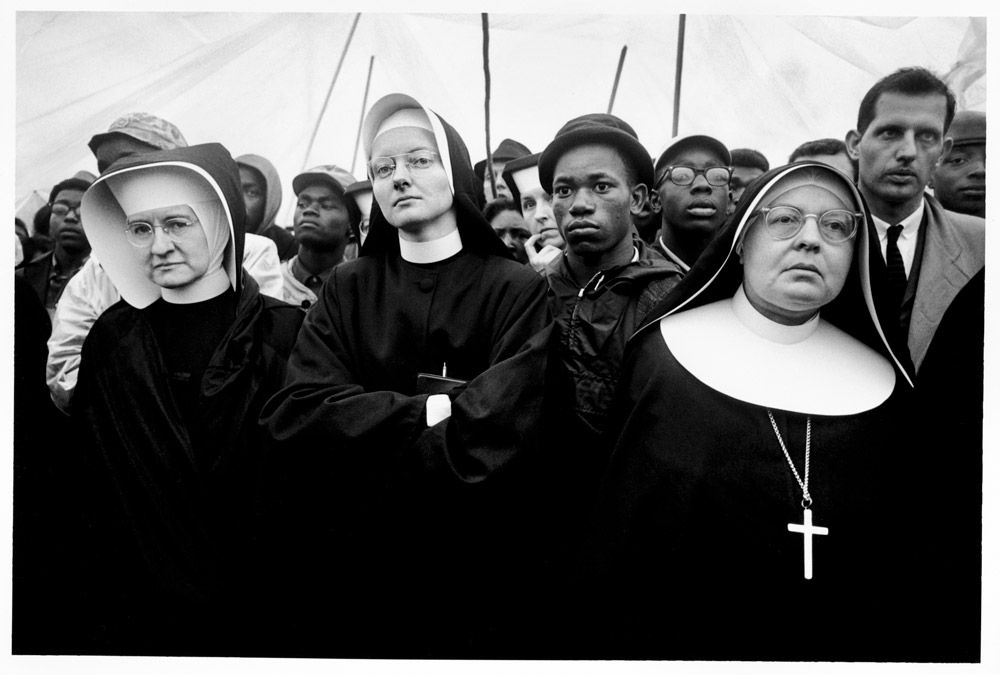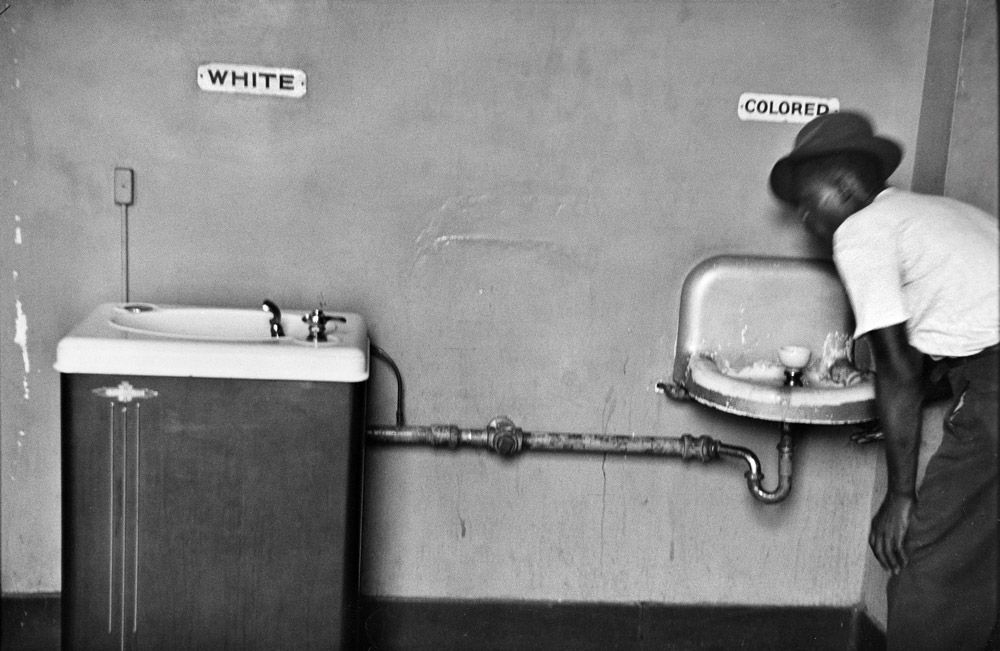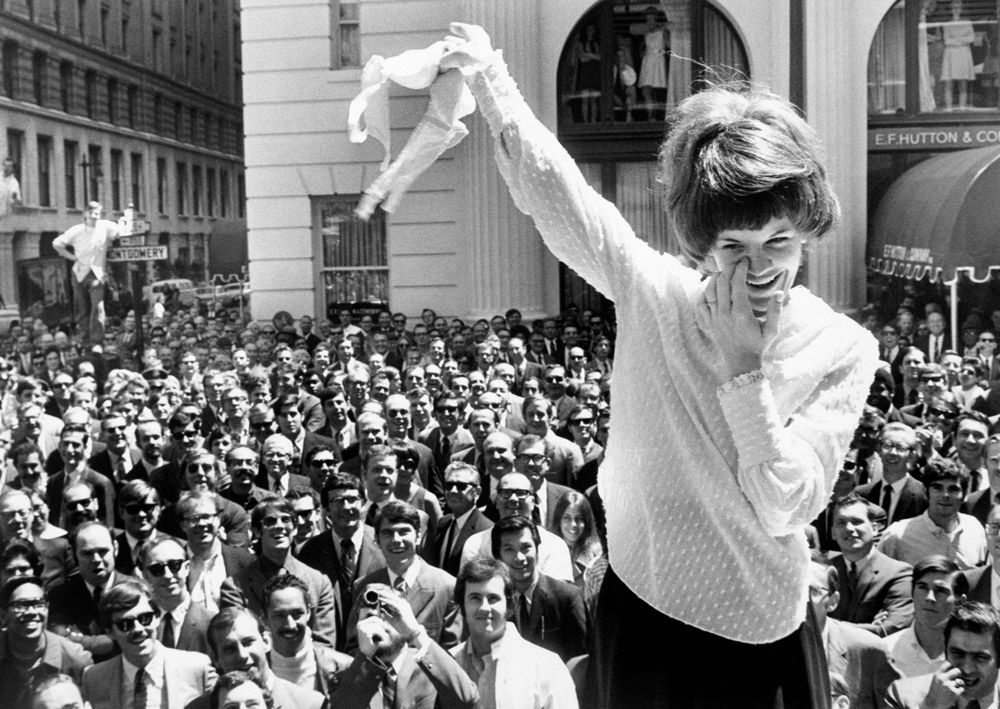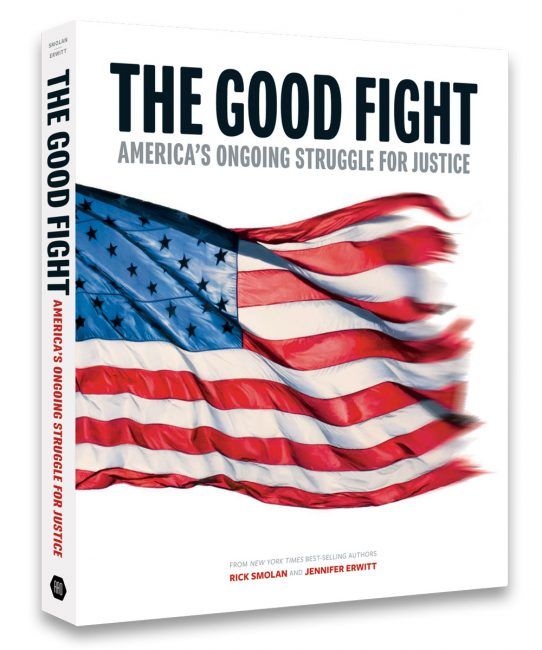blog
Book Review: The Good Fight by Rick Smolan and Jennifer Erwitt

Selma, Alabama, 1965. Americans from around the country joined together for the historic civil rights march from Selma to Montgomery, the Alabama state capital. Led by Martin Luther King Jr., the marchers were attacked and beaten back twice by state and local police, drawing attention to their demand for enforcement of African American voting rights, President Lyndon Johnson dispatched National Guard troops to protect the protesters. On their third attempt, the marchers finally reached Montgomery.
Photograph by Steve Shapiro
Until very recently (until the Trump-phenomenon, that is), I took democracy and what it implies (equal rights, for instance) somehow for granted. Sure, I knew that women do not get equal pay for the same work as men do and, needless to say, I was also aware of the fact that real democracy nowhere really exists (“The best democracy money can buy”, journalist Greg Palace called his book on American democracy) yet I somehow believed that nobody in their right mind would question the fundamental principle that all human beings should be entitled to the same opportunities. And then Trump got elected and it became increasingly apparent that not everybody, as I had erroneously assumed, shared the same principles.
“THE GOOD FIGHT captures the sporadically violent, often triumphant, always risky struggles of Americans who have experienced hatred, oppression or bigotry because of their gender, skin color, country of origin, religion, sexual orientation, disability or beliefs over the past 100 years”, reads the press release that sums up nicely what this book is all about.
THE GOOD FIGHT also gives testimony to the fact that America is made up of lots of minorities. This is how chapters are entitled: African Americans, Japanese Americans, Jewish Americans, Muslim Americans, Latino Americans – one of the strongest, and most disturbing, pictures shows thousands of backpacks, abandoned by immigrants trying to cross Arizona’s Sonoran Desert – , American Women, LGBTQ Americans, Disabled Americans.

Wilmington, North Carolina, 1950. Segregated Water. If “separating the races” were the goal, then why were the two water fountains so close together? The answer ist that physical proximity wasn’t the issue, social division was. Segregation was about enforcing a racial hierarchy and ensuring that state and private resources were funneled to whites rather than blacks. As such, it didn’t matter that water fountains were right next to each other, as long as whites got to use the better water fountain and blacks were made aware of the fact that theirs was inferior. Segregation of public facilities – including water fountains and restrooms – was officially outlawed by the Civil Rights Act of 1964, signed into law by Lyndon B. Johnson after a rare cloture vote in the U.S. Senate. (West Virginia Senator Robert F. Byrd, a former Klansman, spoke against the bill on the Senate Floor for 24 hours, 13 minutes straight.)
Photograph by Elliot Erwitt.
It is a great, impressive and important book. “We have been fortunate that so much of this extraordinary history has played out, and continues to play out, in front of the cameras”, Todd Brewster writes and I do have (almost) nothing but praise for THE GOOD FIGHT. The “almost” refers to the oh so typical (North)American trait of boastful self-applauding (Todd Brewster is not just a journalist but an award-winning journalist; Bret Stephens thinks the United States exceptional because of “the unique power of national regeneration and moral renewal”, the photographers and infographic designers belong to the world’s leading artists etc. etc.) that I find rather difficult to stomach.
It is of course nothing new that the people who inhabit the landmass called North America think of themselves as exceptional. Alexis de Tocqueville attested to that already in 1835/1840, in his book “Democracy in America”. And, it goes without saying, that in many respects, the US is indeed exceptional. That however is also how the Chinese think about China, the Japanese about Japan and the Swiss about Switzerland – although not as loudly.
Rick Smolan, who, together with his partner, Jennifer Erwitt, and with the generous help of the Anti-Defamation League, created this formidable tome, explains that THE GOOD FIGHT has three goals. 1) to remind readers about the extraordinary achievements of the many groups featured in this book, 2) to acknowledge America’s failings in order to not make the same mistakes again, 3) to shatter the complacency “with which so many Americans live, the way so many of us take so many hard-fought battles of the past for granted.” Not only in America, I feel like adding, in many other countries too.
The photographs, some in color, some in black and white, are stunning. To quite some I felt especially drawn. Especially the one taken on November 14, 1960, in New Orleans, made me stop for a long while. It shows three federal officials who accompany first-grader Ruby Bridges to the William Frantz Elementary School, making her the first African-American student to desegregate a Southern public school. I still can hardly believe what my eyes are showing me – what is going on in some people’s minds that make them oppose desegregation? Another pic that I can hardly get out of my head shows Anti-Trump protesters in New York whose hate and readiness to resort to violence respectively is palpable. One of my favorite and most uplifting images is a color shot taken on June 26, 2015, in front of the Supreme Court in Washington, D.C.. It shows a delighted Pooja Mandagaree receiving a kiss from Natalie Thompson, as they celebrate the historic ruling legalizing same sex marriages in the United States.

San Francisco, 1969. In the 1960s, the Women’s Liberation movement targeted bras as symbols of female servitude and male oppression. But contrary to popular lore, few women actually burned their bras as a public protest. That legend stemmed from a feminine protest at the 1969 Miss America beauty pageant in Atlantic City. New Jersey, where women threw their bras, along with mops, pots, and feminine products into a “freedom trash can” in defiance of traditional female roles. A female reporter at the demonstration drew an analogy between the feminist protesters and opponents of the Vietnam War, many of whom had burned their draft cards. As a result, the bra-burning trope erroneously became a catchphrase of the feminist era. Particularly among male detractors, who used it to ridicule the women’s movement.
Photograph from the Bettmann Collection
THE GOOD FIGHT is also full of valuable and helpful information that make me see the world with a new pair of glasses once again. I knew, for instance, that Donald Trump was once counseled in business and legal matters by a man called Roy Cohn, who “advised Trump to always attack and never apologize, honing the belligerent, win-at-all-costs style that came to define Trump’s public persona.” What I however did not know: Mr Cohn was “the red-baiting chief counsel for Senator Joseph McCarthy, whose tactics became synonymous with intimidation and demagoguery.”
“Those who do not remember the past are condemned to repeat it”, George Santayana famously said. This tome not only reminds us of events we might have forgotten or never heard of, it also tells us why the work of the Anti-Defamation League is so important. Did you, for instance, know that Washington refused to accept a boatload of Jewish refugees fleeing from Hitler in 1939? It is disturbing, and sobering, to realize that people do not easily learn from history.
Photographs convey feelings, they can also be (and many in this tome are) an invitation to feel compassion. What makes THE GOOD FIGHT so compelling is the combination of photographs and the informative captions (that make once again clear why documentary photographs need detailed captions) as well as the well-written essays. I felt especially moved by George Takei’s “When barbed wire was home” and Zak Ebrahim’s “I am the son of a terrorist: Here is how I chose peace”.
THE GOOD FIGHT is an illustrated history of social progress that often made me pause in utter disbelief (“… as recently as 1973, banks wouldn’t issue a woman a credit card in her own name or provide her with a loan without a male co-signer.”). It is a convincing and necessary book, inspiring and superbly timely. For rarely, or so it seems, has democratic progress been as endangered as nowadays.

THE GOOD FIGHT
AMERICA’S ONGOING STRUGGLE FOR JUSTICE
by Rick Smolan and Jennifer Erwitt
Sterling Publishing, New York 2017
Location: Online Type: Book Review
Events by Location
Post Categories
Tags
- Abstract
- Alternative process
- Architecture
- Artist Talk
- Biennial
- Black and White
- Book Fair
- Car culture
- charity
- Childhood
- Children
- Cities
- Collaboration
- Cyanotype
- Documentary
- environment
- Event
- Exhibition
- Family
- Fashion
- Festival
- Film Review
- Food
- Friendship
- FStop20th
- Gun Culture
- Italy
- journal
- Landscapes
- Lecture
- love
- Masculinity
- Mental Health
- Museums
- Music
- Nature
- Night
- photomontage
- Podcast
- Portraits
- Prairies
- River
- Still Life
- Street Photography
- Tourism
- UFO
- Wales
- Water
- Zine

Leave a Reply